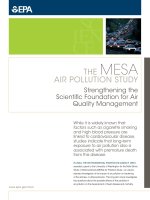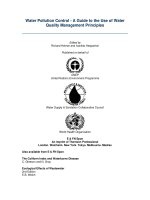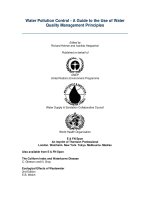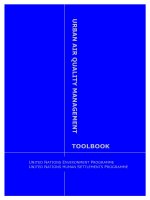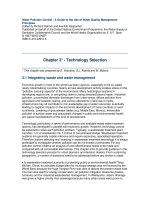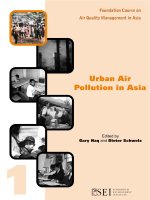Principles of air quality management
Bạn đang xem bản rút gọn của tài liệu. Xem và tải ngay bản đầy đủ của tài liệu tại đây (7.65 MB, 360 trang )
Tai Lieu Chat Luong
7099_C000.fm Page i Monday, July 24, 2006 2:52 PM
PRINCIPLES OF
Air
Quality
Management
SECOND EDITION
7099_C000.fm Page ii Monday, July 24, 2006 2:52 PM
7099_C000.fm Page iii Monday, July 24, 2006 2:52 PM
PRINCIPLES OF
Air
Quality
Management
SECOND EDITION
Roger D. Griffin
Boca Raton London New York
CRC is an imprint of the Taylor & Francis Group,
an informa business
7099_C000.fm Page iv Monday, July 24, 2006 2:52 PM
CRC Press
Taylor & Francis Group
6000 Broken Sound Parkway NW, Suite 300
Boca Raton, FL 33487-2742
© 2007 by Taylor & Francis Group, LLC
CRC Press is an imprint of Taylor & Francis Group, an Informa business
No claim to original U.S. Government works
Printed in the United States of America on acid-free paper
10 9 8 7 6 5 4 3 2 1
International Standard Book Number-10: 0-8493-7099-X (Hardcover)
International Standard Book Number-13: 978-0-8493-7099-1 (Hardcover)
This book contains information obtained from authentic and highly regarded sources. Reprinted
material is quoted with permission, and sources are indicated. A wide variety of references are
listed. Reasonable efforts have been made to publish reliable data and information, but the author
and the publisher cannot assume responsibility for the validity of all materials or for the consequences of their use.
No part of this book may be reprinted, reproduced, transmitted, or utilized in any form by any
electronic, mechanical, or other means, now known or hereafter invented, including photocopying,
microfilming, and recording, or in any information storage or retrieval system, without written
permission from the publishers.
For permission to photocopy or use material electronically from this work, please access www.
copyright.com ( or contact the Copyright Clearance Center, Inc. (CCC)
222 Rosewood Drive, Danvers, MA 01923, 978-750-8400. CCC is a not-for-profit organization that
provides licenses and registration for a variety of users. For organizations that have been granted a
photocopy license by the CCC, a separate system of payment has been arranged.
Trademark Notice: Product or corporate names may be trademarks or registered trademarks, and
are used only for identification and explanation without intent to infringe.
Library of Congress Cataloging-in-Publication Data
Griffin, Roger D.
Principles of air quality management / Roger D. Griffin. -- 2nd ed.
p. cm.
Includes bibliographical references and index.
ISBN 0-8493-7099-X (alk. paper)
1. Air quality management. I. Title.
TD883.G78 2006
363.739’2--dc22
Visit the Taylor & Francis Web site at
and the CRC Press Web site at
2006045606
7099_C000.fm Page v Monday, July 24, 2006 2:52 PM
Dedication
Still dedicated to those who seek the Truth in all things,
and to Him Who is
7099_C000.fm Page vi Monday, July 24, 2006 2:52 PM
7099_C000.fm Page vii Monday, July 24, 2006 2:52 PM
Preface to the Second Edition
In the years since the first edition, we have seen new trends that this author did not
think possible when he began his environmental career in 1969. Today there are far
fewer “smog alerts,” far fewer acute-health impacts, a far greater acceptance of clean
fuels and clean technologies, new engine systems, and a far greater understanding
of the sources of air emissions — both natural and man-made. (Air quality improvements are detailed in Chapter 10.)
On an international scale, air quality issues being addressed include the concern
for indoor air quality in developing nations, the push for clean fuels worldwide, and
the search for newer, less polluting technologies for industry and control systems.
It is worth noting that the stratospheric ozone layer over Antarctica — once predicted
as taking decades to improve — is increasing.
If the estimated methane reserves of 400 million tcf (trillion cubic feet) discovered in gas hydrates offshore can be accessed, the entire energy paradigm will shift
dramatically to clean fuels.
While our goal is the same as in our first edition — “giving the reader a firm
grasp of the principles that make up the broad field of air quality, its pollution and
its management” — we are also celebrating the successes we have seen over the
past 40 years of a concerted effort directed toward clean air. I would like to pay
tribute to the thousands who have spent myriad hours studying the atmosphere,
devising technologies for clean fuels, clean engines and new control systems, investigating health effects, reviewing historical information on climate, monitoring the
air, preparing new management strategies, evaluating rules and regulations, and
guiding the energies and industries of a modern society in new directions. To you
we say thank you.
7099_C000.fm Page viii Monday, July 24, 2006 2:52 PM
7099_C000.fm Page ix Monday, July 24, 2006 2:52 PM
Preface to the First Edition
In order to understand and manage our air quality resources, it is necessary to gain
a fundamental understanding of the principles that govern our ability to do so.
From a local perspective, it may be considered desirable to install huge fans in
order to “blow the smog away,” but from a technological and scientific perspective
it is not feasible. Likewise, from a regional or continental perspective, it is not
acceptable to merely transfer air contaminants from one location to another one by
dilution or “blowing it away.”
It is therefore the purpose of this book to give the reader a firm grasp of the
principles that make up the broad field of air quality, its pollution, and its management. Starting from the basic definitions of air and types of air pollution, we will
follow some of its history through the present century. From that perspective, we
will look at the terms used: air quality, emissions, standards and classifications of
pollutants, and the production of secondary air pollution or photochemical smog.
We next look at the health effects of the criteria air pollutants and those that are
considered toxic or hazardous, and the effects of those contaminants on the human
body. Air pollutant damages to materials and vegetation are also reviewed. The
standards of acceptable air quality from the perspective of health impacts (chronic
through emergency episode concentrations) and the techniques for measuring air
quality are also reviewed.
We approach the sources of air contaminants from an anthropogenic as well as
geogenic and biogenic perspective. Between sources and receptors we look at how
contaminants are dispersed into the atmosphere from a local, regional, and global
perspective. From these studies come an evaluation of the different models used to
calculate dispersion and the models used to predict ambient air quality.
Federal laws and regulations as well as regional perspectives are summarized
and evaluated. Control technologies that are available for both stationary sources
and mobile sources are reviewed. From these, we are able to evaluate the possible
management options for limiting emissions and optimizing air pollutant strategies.
Global air quality concerns, relative global emissions, and the alternative views
are evaluated from the perspective of management options that may be available to
society at large. Of particular concern are those that may influence long-term air
quality and health. Finally, we will be looking at indoor air quality and the future
trends in air quality management approaches, with their limitations.
7099_C000.fm Page x Monday, July 24, 2006 2:52 PM
7099_C000.fm Page xi Monday, July 24, 2006 2:52 PM
The Author
Roger D. Griffin has more than 35 years of technical and management expertise
as a result of working on numerous environmental problems. He has in-depth
experience in the design, evaluation, and testing of existing and planned combustion,
air pollution, waste-to-energy, and hazardous waste sources and control technologies,
combined with several years of advanced study of pollutant formation and dispersion
from point and area sources.
He has served as an expert witness in cases involving air toxics, contaminated
properties, and remediation. His master’s thesis was a field validation of the Gaussian
plume dispersion model; the antecedent of EPA’s ISC and AERMOD dispersion
models. He has conducted remedial investigations at Superfund sites.
Mr. Griffin has worked with local government agencies throughout his career,
including the County of Orange (California), and the South Coast Air Quality
Management District and its predecessor agencies. He has held positions with the
Ecology Auto companies (director of Environmental Compliance), Converse Consultants (president and managing officer), CH2M-Hill, US Ecology, and KVB Engineering. He has served in various capacities in his career: analyzing air samples for
trace pollutants; and as a field inspector, source testing specialist, permit processing
engineer, project manager, and principal-in-charge.
His projects have included working on secondary aluminum foundries; performing dispersion modeling and health risk assessments for permits to operate combined
cycle power systems; providing expert witness testimony for cases involving hazardous air pollutant emissions from a railroad tank car derailment and spill; performing extensive NOx testing and control programs on standard and alternative
fuels; and providing on-site reviews and evaluations of operating European and
United States incineration facilities, determining hazardous and toxic emission levels, emissions test methods, and best control technologies for toxic air contaminants.
Mr. Griffin has worked on biomass fuel systems (rice hull burner and cow manure
combustion systems); performed alternative control technologies and process change
evaluations for effectiveness and costs to control odors.
His other activities have included preparing hearing board cases, testifying as
an expert witness, supervising special studies, preparing emission inventories, and
evaluating technological and economic impacts of New Source Review regulation.
In addition, he has worked for industrial clients in the food preparation, metallurgical,
chemical, petroleum, and power generation industries.
In his earlier years, Mr. Griffin supervised a source test team, was responsible
for ambient air monitoring instrument calibrations, and advised on methods of air
sampling analysis.
He taught for 10 years at UCLA and UC–Irvine in their Environmental Engineering Extension program, teaching air quality and hazardous materials
7099_C000.fm Page xii Monday, July 24, 2006 2:52 PM
management. He has a master’s degree in engineering, a bachelor’s degree in chemistry, and is a registered chemical engineer in California.
CONTRIBUTOR
Benjamin K. Griffin practices law as an associate for Bois & Macdonald, an
environmental law firm in Irvine, California. In his practice, he has worked with the
South Coast Air Quality Management District (SCAQMD), the California Department of Toxic Substances Control (DTSC), regional water quality control boards,
the Los Angeles County Health and Hazardous Materials Division, and the County
of San Diego Department of Environmental Health. He works on matters regarding
CERCLA, RCRA, USTCF, and NPL listed sites. He also has worked on claims
involving construction delay and inverse condemnation.
He earned his J.D. degree from Pepperdine University School of Law. While in
law school, Mr. Griffin distinguished himself as a member of the Law School Honor
Board, serving as prosecutor. During his second year of law school he was selected
as a Blackstone Fellow.
Mr. Griffin earned his B.A. degree from The Citadel, with department honors,
in political science, international politics, and military affairs.
Mr. Griffin is a member of the State Bar of California, the U.S. District Court,
Central District of California, the American Bar Association, and the Environmental
Law Section of the Orange County Bar Association.
7099_C000.fm Page xiii Monday, July 24, 2006 2:52 PM
Acknowledgments
The following individuals are acknowledged for their contributions to this book and
to a greater understanding of the field of air quality management:
Dr. Kathryn Kelly of Delta Toxicology, Inc.
Michael Oard, Retired Meteorologist
Dr. James Pitts of the University of California, Riverside
Dr. Scott Samuelson of the University of California, Irvine
Dr. Larry Vardiman of the Institute of Creation Research
A special acknowledgment is given to my wife, Dr. Avice Marie Griffin, without
whose encouragement this book would not have been possible.
7099_C000.fm Page xiv Monday, July 24, 2006 2:52 PM
7099_C000.fm Page xv Monday, July 24, 2006 2:52 PM
Contents
Chapter 1
The Atmosphere and Its Contaminants ...............................................1
History of Air Pollution.............................................................................................1
Medieval Experiences ......................................................................................1
Industrialization................................................................................................2
The Early 20th Century ...................................................................................2
The Great London Smog Disaster — December 1952...................................3
Late 20th and Early 21st Centuries .................................................................4
Terms and Definitions................................................................................................4
Ambient Air......................................................................................................4
Criteria and Noncriteria Air Pollutants............................................................5
Emissions .........................................................................................................6
The Epidemiologic Model ...............................................................................7
Components of the Atmosphere ................................................................................7
Physical Characteristics ...................................................................................8
Standard Conditions.........................................................................................9
Dew Point and Humidity .................................................................................9
States of Air Pollutants............................................................................................10
Pollutant Gas Features ...................................................................................10
Particulate Features ........................................................................................10
Contaminant Classifications ....................................................................................13
Primary Contaminants....................................................................................13
Natural Emissions ..............................................................................14
Anthropogenic Emissions ..................................................................14
Secondary Contaminants................................................................................14
Photochemical Smog ...............................................................................................14
Air Quality Management Aspects of Photochemical Reactions...................18
Chapter 2
Effects of Air Pollution......................................................................21
Time Effects and Sensitivities .................................................................................21
Acute versus Chronic.....................................................................................21
Sensitive Populations .....................................................................................22
Criteria versus Noncriteria Air Pollutants...............................................................22
Criteria Air Pollutant Effects .........................................................................23
Ozone .................................................................................................23
Sulfur Dioxide....................................................................................24
Particulate Matter ...............................................................................26
Nitrogen Dioxide................................................................................26
Carbon Monoxide ..............................................................................27
Lead ....................................................................................................27
7099_C000.fm Page xvi Monday, July 24, 2006 2:52 PM
Basic Principles of Toxicology ...............................................................................28
Sources of Health Effects Information ..........................................................28
Dose–Response ..............................................................................................29
Routes of Exposure .................................................................................................30
Inhalation........................................................................................................30
Response to Airborne Chemicals ............................................................................30
The Lungs ......................................................................................................31
The Central Nervous System .........................................................................33
The Liver ........................................................................................................33
The Kidneys ...................................................................................................33
The Blood.......................................................................................................33
The Reproductive System ..............................................................................33
The Cardiovascular System ...........................................................................34
The Skeletal System.......................................................................................34
Other Factors to Consider..............................................................................34
Classes of Health Effects.........................................................................................35
Latency ...........................................................................................................36
Carcinogens ....................................................................................................36
Mutagens ........................................................................................................36
Teratogens ......................................................................................................36
Effects on the Ecosystem ........................................................................................37
Effects on Vegetation .....................................................................................37
Plant Structure....................................................................................37
Leaf Structure.....................................................................................37
Plant Injury.........................................................................................38
Acid Precipitation Effects ..................................................................38
Pollutant Interactions .........................................................................39
Economic Losses Caused by Vegetation Effects...............................39
Effects on Materials .......................................................................................39
Textiles ...............................................................................................40
Building Materials..............................................................................40
Metal Corrosion .................................................................................41
Surface Coatings ................................................................................42
Documents and Manuscripts..............................................................42
Rubber ................................................................................................42
Effects on Animals.........................................................................................43
Economic Losses .....................................................................................................43
Chapter 3
Air Quality Standards and Monitoring..............................................45
Standards..................................................................................................................45
Acceptable Levels ..........................................................................................46
Ambient Air Standards and Exposures ...................................................................48
National ..........................................................................................................48
International Air Pollution Levels .................................................................50
7099_C000.fm Page xvii Monday, July 24, 2006 2:52 PM
The Pollution Standard Index..................................................................................51
Episodic Standards.........................................................................................52
Noncriteria Air Contaminant Standards ..................................................................53
Occupational Derived Standards....................................................................53
Risk Assessment ......................................................................................................54
The Risk Assessment Process........................................................................54
Hazard Identification..........................................................................54
Dose–Response Assessment ..............................................................55
Exposure Assessment.........................................................................56
Risk Characterization.........................................................................57
Uncertainties...................................................................................................57
Uncertainties in Toxicity....................................................................57
Uncertainties in Modeled Exposures.................................................58
Screening Level Approaches..........................................................................58
Carcinogen Hazards ...........................................................................58
Acceptable Air Quality ............................................................................................61
Monitoring Ambient Air Quality.............................................................................61
Measurement Techniques ........................................................................................63
Cumulative Samplers .....................................................................................64
Continuous Analyzers ....................................................................................66
Chapter 4
Sources and Measurement Methodologies ........................................69
Global Sources.........................................................................................................70
Geogenic.........................................................................................................70
Biogenic .........................................................................................................70
Anthropogenic ................................................................................................71
Global Emissions ...........................................................................................72
Air Pollution Sinks ..................................................................................................74
Biological Sinks .............................................................................................74
Mechanical Sinks ...........................................................................................74
Photochemical Sinks ......................................................................................75
Anthropogenic Air Emissions .................................................................................76
Combustion ....................................................................................................76
Fuels for Combustion Reactions....................................................................77
Coal ....................................................................................................77
Liquid Fuels .......................................................................................79
Natural Gas ........................................................................................80
Efficiency and Emissions ...................................................................81
Enthalpy Considerations ................................................................................81
Air and Fuel Considerations ..............................................................82
Combustion Chemistry.......................................................................82
Air-to-Fuel Ratio Considerations.......................................................83
Combustion Systems......................................................................................84
7099_C000.fm Page xviii Monday, July 24, 2006 2:52 PM
Evaporative Emissions.............................................................................................85
Evaporative Classes........................................................................................87
Fugitive Emissions...................................................................................................88
Waste-Related Emissions.........................................................................................89
Landfills..........................................................................................................89
Treatment-Related Emissions ........................................................................91
Criteria Air Pollutant Formation .............................................................................91
Source Inventories of Criteria Pollutants ................................................................92
Transportation ................................................................................................93
Fuel Combustion ............................................................................................93
Industrial Processes........................................................................................94
Miscellaneous.................................................................................................95
Comparisons by Category..............................................................................95
Hazardous Air Emissions ........................................................................................96
Quantification of Emissions ....................................................................................97
Source Testing................................................................................................97
Continuous Emissions Monitoring ................................................................97
Carbon Balance ..............................................................................................98
Composition ...................................................................................................98
Emission Factors ............................................................................................98
Fugitives .........................................................................................................99
Accuracy and Applicability .....................................................................................99
Chapter 5
Meteorology, Dispersion, and Modeling .........................................101
Earth’s Energy and Radiation................................................................................101
Temperature and Global Air Movements ....................................................103
Global Circulation Cells ..................................................................104
Jet Streams .......................................................................................105
Surface Effects .................................................................................105
Other Forces .................................................................................................107
Patterns of High and Low Pressure .............................................................107
Friction .............................................................................................111
Horizontal and Vertical Air Patterns............................................................111
Atmospheric Stability ......................................................................111
Vertical Mixing ................................................................................113
Horizontal Air Movements ..............................................................113
Regional Air Pollution Meteorology .....................................................................115
Inversions .....................................................................................................115
Types of Inversions ......................................................................................115
Southern California — The Classic Example .............................................117
Sea and Land Breezes..................................................................................117
Other Dispersive Characteristics of the Atmosphere ..................................119
Valley Effects ...................................................................................119
Chimney Effect ................................................................................121
Vegetation Effects ............................................................................121
7099_C000.fm Page xix Monday, July 24, 2006 2:52 PM
Mountain Effects..............................................................................122
Urban Heat Island Effects................................................................122
Local Air Pollutant Dispersion..............................................................................123
Point Sources and Plume Dispersion ..........................................................123
Plume Rise ...................................................................................................124
Plume Shape.................................................................................................125
Line Sources.................................................................................................127
Area Sources ................................................................................................128
Dispersion Modeling .............................................................................................128
Point-Source Modeling ................................................................................129
Model Averaging Time ................................................................................131
Plume Model Modifications.........................................................................131
Line-Source Models.....................................................................................133
Area Modeling .............................................................................................133
Catastrophic Releases ..................................................................................133
Visibility.................................................................................................................134
Mathematical Models ............................................................................................134
Planning Based.............................................................................................134
Receptor Based ............................................................................................136
Statistical Based ...........................................................................................136
Chapter 6
Stationary-Source Control Approaches ...........................................139
Source Reduction...................................................................................................139
Management and Operational Changes ................................................................140
Fugitive Emissions .......................................................................................141
Product Storage Control...............................................................................142
Materials Changes........................................................................................144
Process-Optimizing Actions ..................................................................................145
Combustion Modifications.....................................................................................146
Fuels and Fuel Modification..................................................................................151
Efficiency......................................................................................................151
Secondary Utilization...................................................................................151
Fuel Switching .............................................................................................152
Fuel Blending...............................................................................................152
Fuel Cleaning ...............................................................................................153
Additives.......................................................................................................154
Fuel Modifications .......................................................................................154
Fuel Refining................................................................................................156
Planning and Design..............................................................................................156
Geographic Location....................................................................................156
Lower-Emission Systems.............................................................................157
Greater Efficiency ........................................................................................158
Repowering ..................................................................................................158
Emissions Characterization ...................................................................................158
Collection of Air Contaminants ............................................................................159
7099_C000.fm Page xx Monday, July 24, 2006 2:52 PM
Air Pollution Control Approaches.........................................................................162
Gas Control Technologies............................................................................162
Absorbers .........................................................................................163
Adsorbers .........................................................................................164
Condensers .......................................................................................165
Thermal Oxidation ...........................................................................166
Particulate Control Technologies .................................................................167
Mechanical Collectors......................................................................168
Fabric Filters ....................................................................................169
Wet Scrubbers ..................................................................................171
Electrostatic Precipitators ................................................................172
Combination Units ...........................................................................173
Combustion Gas Control Technologies.................................................................174
Carbon Monoxide and Combustible Carbon Gases ....................................174
Sulfur Dioxide..............................................................................................174
Oxides of Nitrogen.......................................................................................174
Selective Catalytic Reduction ..........................................................176
Selective Noncatalytic Reduction ....................................................176
Oxidative Systems............................................................................177
Technology Comparisons ......................................................................................177
Control System Hardware Considerations ..................................................178
Chapter 7
Mobile Sources and Control Approaches........................................179
Engines and Air Pollutant Emissions....................................................................179
Pollutant Formation in Spark-Ignited Engines .....................................................181
Bulk Gas Pollutant–Formation Region........................................................181
Surface Pollutant–Formation Region...........................................................182
Four-Stroke Pollutant Mechanisms..............................................................183
Lesser Sources of Carbon Gas Pollutant Emissions ...................................183
Fuel Composition and Exhaust Emissions ..................................................185
Diesel Ignition Emission Characteristics ..............................................................185
Pollutant Patterns .........................................................................................188
Hydrocarbon Emissions from Trip Cycles ..................................................188
Engine Thermodynamic Cycles...................................................................189
Hybrid Internal Combustion Engines....................................................................192
ICE Emission-Control Options .............................................................................193
Effects of Operating Conditions ..................................................................193
Spark Timing................................................................................................193
Compression Ratio.......................................................................................193
Engine Speed................................................................................................194
Engine Power ...............................................................................................194
Engine Temperatures....................................................................................195
Engine Cleanliness.......................................................................................195
Design Influences on ICEs ....................................................................................196
Two-Stage Combustion ................................................................................197
7099_C000.fm Page xxi Monday, July 24, 2006 2:52 PM
External Control Approaches ................................................................................198
Fuel Recapture Systems...............................................................................198
Catalyst Systems ..........................................................................................198
Diesel Particulate Controls ..........................................................................200
Fuel Change Effects ..............................................................................................200
Diesel Fuels..................................................................................................204
Alternatives and the Future ...................................................................................205
Alternative Fuels ..........................................................................................205
Alternative Mechanical Design and Efficiency Approaches .......................206
Alternative Power Systems ..........................................................................206
Chapter 8
Global Concerns...............................................................................209
The Challenge........................................................................................................210
Data and Records .........................................................................................210
Intercontinental Pollutant Transport......................................................................211
The Data.......................................................................................................212
Conclusions ..................................................................................................213
Stratospheric Ozone...............................................................................................213
Radiation Primer ..........................................................................................213
Stratospheric Ozone Formation ...................................................................215
Early Observations .......................................................................................216
The Response ...............................................................................................216
Other Sources and Variations.......................................................................216
Lab Studies...................................................................................................217
Antarctic Studies ..........................................................................................217
UV Data and Other Impacts ........................................................................218
Alternatives...................................................................................................219
Acid Deposition .....................................................................................................220
Water Plus Air ..............................................................................................220
Water Plus Soils ...........................................................................................220
Acid Rain Studies ........................................................................................221
The NAPAP Findings...................................................................................222
Conclusions ..................................................................................................224
Global Climate Change .........................................................................................224
Historical Perspective...................................................................................225
Current Concerns .........................................................................................227
Measurements...............................................................................................231
Other Considerations....................................................................................235
Feedbacks .....................................................................................................235
Models..........................................................................................................236
Recent Findings............................................................................................237
Alternative Views...................................................................................................238
Increased Yields ...........................................................................................239
Other Agricultural Effects............................................................................240
7099_C000.fm Page xxii Monday, July 24, 2006 2:52 PM
Chapter 9
Air Quality Laws and Regulations ..................................................243
General Law Approaches ......................................................................................243
Public Nuisance............................................................................................243
Private Nuisance...........................................................................................244
Recent Approaches.......................................................................................244
The Process of Regulation...........................................................................245
Role of the Public in Rule Making .............................................................245
Environmental Justice ..................................................................................246
Levels of Authority ......................................................................................246
Federal Preemption ......................................................................................246
Federal Laws Affecting Air Quality Management................................................247
Pre-1990 Air Quality Acts and Effects........................................................247
Implementation Plans.......................................................................248
Monitoring and Limiting Emissions................................................248
Prevention of Significant Deterioration ...........................................248
Emergency Episodes ........................................................................249
Hazardous Air Pollutants .................................................................250
Global Concerns...............................................................................250
Federal Environmental Statutes .......................................................250
Toxic Substances Control Act..........................................................250
Resource Conservation and Recovery Act ......................................250
Comprehensive Emergency Response, Compensation, and
Liability Act ...................................................................................251
The Clean Air Act..................................................................................................252
Title I — Attainment and Maintenance of the NAAQS .............................253
Ozone Nonattainment Requirements ...............................................254
Additional Ozone Strategies ............................................................256
Carbon Monoxide Nonattainment Provisions .................................258
PM10 Nonattainment Areas.............................................................259
PM2.5 Nonattainment Areas............................................................260
Title II — Mobile Source Provisions ..........................................................260
Light-Duty Vehicle Standards..........................................................260
Tailpipe Toxics .................................................................................261
Emissions Control ............................................................................261
Reformulated Gasoline Fuel Requirements.....................................262
Phase II Reformulated Gasoline Performance Standards ...............262
California Low-Emission Vehicle II Regulations............................263
Title III — Hazardous Air Pollutant Program.............................................263
Toxic Release Inventory Program....................................................264
HAP Sources ....................................................................................264
Area Sources: Urban Air Toxics Strategy .......................................266
SIP Revisions ...................................................................................266
HAP Permits ....................................................................................266
Special Studies .................................................................................266
Clean Air Mercury Rule ..................................................................266
7099_C000.fm Page xxiii Monday, July 24, 2006 2:52 PM
Prevention of Accidental Releases...................................................267
Solid Waste Combustion ..................................................................268
Title IV — Acid Deposition Program .........................................................268
SO2 Provisions — Clean Air Interstate Rule 2005 Effect ..............268
Market-Based Allowance Program ..................................................269
NOx Provisions — Budget Training Program .................................269
Other Provisions...............................................................................270
Title V — Operating Permits.......................................................................270
Permit Program Requirements.........................................................271
Fees...................................................................................................271
Other Provisions...............................................................................272
Valid Permits ....................................................................................273
Title VI — Stratospheric Ozone Protection ................................................273
Recapture and Recycling .................................................................274
Labeling............................................................................................274
Title VII — Enforcement Provisions...........................................................274
Clean Air Crimes .............................................................................274
Title VIII — Miscellaneous Provisions.......................................................275
Visibility and Source Receptor Concepts........................................275
Grand Canyon Visibility Transport Commission ............................275
International Treaties .............................................................................................276
Montreal Protocol ........................................................................................276
Kyoto Accords..............................................................................................276
The Influence of Nonregulatory Governmental Actions.......................................277
Court Decisions............................................................................................278
Chapter 10 Management, Trends, and Indoor Air Quality ................................279
Elements of Air Quality Management .................................................................280
Nonregulatory Air Quality Management Approaches.................................281
Trends.....................................................................................................................282
Trends in Emissions.....................................................................................282
Trends in the Extreme Ozone Area .............................................................283
Trends in Strategy ........................................................................................286
Fuels and Transportation..................................................................286
Small Sources...................................................................................287
Governance.......................................................................................287
Hazardous Air Pollutants .................................................................288
Lifestyle Impacts..............................................................................289
Stationary Sources............................................................................289
Natural Sources ................................................................................290
The Outlook .................................................................................................290
Indoor Air Quality .................................................................................................291
Environmental Tobacco Smoke ...................................................................294
Radon ...........................................................................................................295
7099_C000.fm Page xxiv Monday, July 24, 2006 2:52 PM
Radon in Building Sources ..........................................................................297
Soil ...................................................................................................297
Water ................................................................................................298
Building Materials............................................................................299
Measurement and Action Levels .................................................................299
House Characteristics and Radon Gas Entry ..............................................300
Mitigation .....................................................................................................300
Other Indoor Air Contaminant Concerns ....................................................302
Public Buildings ....................................................................................................304
Indoor Air Pollution in Developing Countries......................................................305
List of Acronyms ...................................................................................................307
Glossary .................................................................................................................311
Bibliography ..........................................................................................................325
Index ......................................................................................................................331
